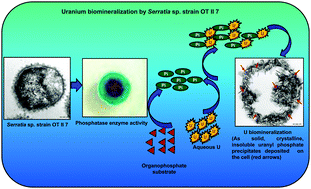当前位置:
X-MOL 学术
›
Metallomics
›
论文详情
Our official English website, www.x-mol.net, welcomes your
feedback! (Note: you will need to create a separate account there.)
Uranium biomineralization induced by a metal tolerant Serratia strain under acid, alkaline and irradiated conditions†
Metallomics ( IF 2.9 ) Pub Date : 2018-07-12 00:00:00 , DOI: 10.1039/c8mt00061a Pallavi Chandwadkar 1, 2, 3, 4 , Hari Sharan Misra 1, 2, 3, 4, 5 , Celin Acharya 1, 2, 3, 4, 5
Metallomics ( IF 2.9 ) Pub Date : 2018-07-12 00:00:00 , DOI: 10.1039/c8mt00061a Pallavi Chandwadkar 1, 2, 3, 4 , Hari Sharan Misra 1, 2, 3, 4, 5 , Celin Acharya 1, 2, 3, 4, 5
Affiliation

|
It has become increasingly apparent that the environmental microorganisms residing in uranium (U) enriched sites offer the possibility of understanding the biological mechanisms catalyzing the processes important for uranium bioremediation. Here, we present the results of uranium biomineralization over a wide pH range by a metal tolerant Serratia sp. strain OT II 7 isolated from the subsurface soil of a U ore deposit at Domiasiat in India. The Serratia cells actively expressed acid and alkaline phosphatase enzymes which hydrolyzed differential amounts of phosphate from an organophosphate substrate in the presence of uranium between pH 5 to 9. These cells precipitated ∼91% uranium from aqueous solutions supplemented with 1 mM uranyl nitrate at pH 5 within 120 h. More rapid precipitation was observed at pH 7 and 9 wherein the cells removed ∼93–94% of uranium from solutions containing 1 mM uranyl carbonate within 24 h. The aqueous uranyl speciation prevalent under the studied pH conditions influenced the localization of crystalline uranyl phosphate precipitates, which in turn, impacted the cell viability to a great extent. Furthermore, the cells tolerated up to ∼1.6 kGy 60Co gamma radiation and their uranium precipitation abilities at pH 5, 7 and 9 were uncompromised even after exposure to a high dose of ionizing radiation. Overall, this study establishes the ecological adaptation of a natural strain like Serratia in a uranium enriched environment and corroborates its contribution towards uranium immobilization in contaminated subsurfaces through the formation of stable uranyl phosphate minerals over a wide pH range.
中文翻译:

耐金属沙雷氏菌菌株在酸性,碱性和辐射条件下诱导的铀生物矿化†
越来越明显的是,富铀(U)场所中的环境微生物为理解催化铀生物修复重要过程的生物学机制提供了可能性。在这里,我们介绍了金属耐受性沙雷氏菌(Serratia sp。)在很宽的pH范围内进行铀生物矿化的结果。从印度Domiasiat铀矿床地下土壤中分离出的OT II 7菌株。该沙雷细胞会主动表达酸性和碱性磷酸酶,在存在pH 5至9的铀的情况下,它们会水解不同数量的磷酸盐从有机磷酸酯底物中分离出来。这些细胞从补充有1 mM硝酸铀酰的水溶液中在120至120%的水中沉淀出约91%的铀。 H。在pH 7和9下观察到了更快的沉淀,其中细胞在24小时内从含1 mM铀酰碳酸酯的溶液中除去了约93–94%的铀。在研究的pH条件下普遍存在的水性铀酰形态影响了结晶磷酸铀酰沉淀的定位,这反过来在很大程度上影响了细胞的活力。此外,细胞可耐受约1.6 kGy 60即使在暴露于高剂量的电离辐射后,γ射线及其在pH 5、7和9时的铀沉淀能力也不会受到损害。总体而言,这项研究建立了富含铀的环境中天然菌株(如沙雷氏菌)的生态适应性,并通过在较宽的pH范围内形成稳定的磷酸铀酰矿物质,证实了其对铀固定在受污染地下的贡献。
更新日期:2018-07-12
中文翻译:

耐金属沙雷氏菌菌株在酸性,碱性和辐射条件下诱导的铀生物矿化†
越来越明显的是,富铀(U)场所中的环境微生物为理解催化铀生物修复重要过程的生物学机制提供了可能性。在这里,我们介绍了金属耐受性沙雷氏菌(Serratia sp。)在很宽的pH范围内进行铀生物矿化的结果。从印度Domiasiat铀矿床地下土壤中分离出的OT II 7菌株。该沙雷细胞会主动表达酸性和碱性磷酸酶,在存在pH 5至9的铀的情况下,它们会水解不同数量的磷酸盐从有机磷酸酯底物中分离出来。这些细胞从补充有1 mM硝酸铀酰的水溶液中在120至120%的水中沉淀出约91%的铀。 H。在pH 7和9下观察到了更快的沉淀,其中细胞在24小时内从含1 mM铀酰碳酸酯的溶液中除去了约93–94%的铀。在研究的pH条件下普遍存在的水性铀酰形态影响了结晶磷酸铀酰沉淀的定位,这反过来在很大程度上影响了细胞的活力。此外,细胞可耐受约1.6 kGy 60即使在暴露于高剂量的电离辐射后,γ射线及其在pH 5、7和9时的铀沉淀能力也不会受到损害。总体而言,这项研究建立了富含铀的环境中天然菌株(如沙雷氏菌)的生态适应性,并通过在较宽的pH范围内形成稳定的磷酸铀酰矿物质,证实了其对铀固定在受污染地下的贡献。











































 京公网安备 11010802027423号
京公网安备 11010802027423号